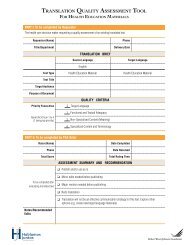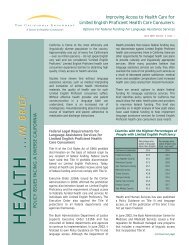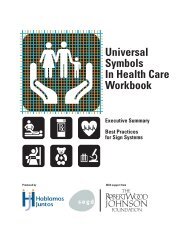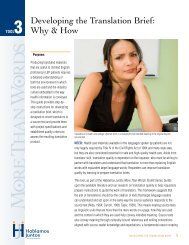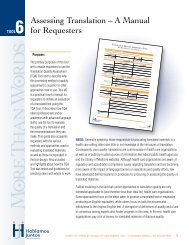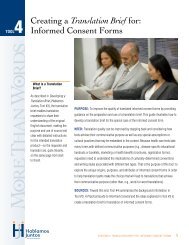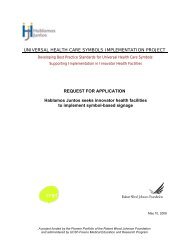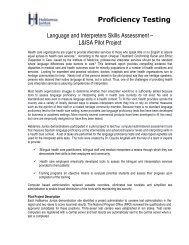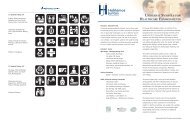Language Use and English-Speaking Ability: 2000 - Census Bureau
Language Use and English-Speaking Ability: 2000 - Census Bureau
Language Use and English-Speaking Ability: 2000 - Census Bureau
Create successful ePaper yourself
Turn your PDF publications into a flip-book with our unique Google optimized e-Paper software.
Four Major <strong>Language</strong> Groups<br />
Spanish includes those who speak Ladino.<br />
Other Indo-European languages include most languages of<br />
Europe <strong>and</strong> the Indic languages of India. These include the Germanic<br />
languages, such as German, Yiddish, <strong>and</strong> Dutch; the Sc<strong>and</strong>inavian<br />
languages, such as Swedish <strong>and</strong> Norwegian; the Romance languages,<br />
such as French, Italian, <strong>and</strong> Portuguese; the Slavic languages, such as<br />
Russian, Polish, <strong>and</strong> Serbo-Croatian; the Indic languages, such as<br />
Hindi, Gujarathi, Punjabi, <strong>and</strong> Urdu; Celtic languages; Greek; Baltic<br />
languages; <strong>and</strong> Iranian languages.<br />
Asian <strong>and</strong> Pacific Isl<strong>and</strong> languages include Chinese; Korean;<br />
Japanese; Vietnamese; Hmong; Khmer; Lao; Thai; Tagalog or Pilipino;<br />
the Dravidian languages of India, such as Telegu, Tamil, <strong>and</strong><br />
Malayalam; <strong>and</strong> other languages of Asia <strong>and</strong> the Pacific, including<br />
the Philippine, Polynesian, <strong>and</strong> Micronesian languages.<br />
All other languages include Uralic languages, such as Hungarian;<br />
the Semitic languages, such as Arabic <strong>and</strong> Hebrew; languages of<br />
Africa; native North American languages, including the American<br />
Indian <strong>and</strong> Alaska native languages; <strong>and</strong> some indigenous languages<br />
of Central <strong>and</strong> South America.<br />
25.6 million people). When they<br />
are combined with those who<br />
spoke only <strong>English</strong> at home,<br />
92 percent of the population aged<br />
5 <strong>and</strong> over had no difficulty speaking<br />
<strong>English</strong>. The proportion of the<br />
population aged 5 <strong>and</strong> over who<br />
spoke <strong>English</strong> less than “Very well”<br />
grew from 4.8 percent in 1980, to<br />
6.1 percent in 1990, <strong>and</strong> to 8.1<br />
percent in <strong>2000</strong>.<br />
In Figure 2, the number of speakers<br />
of the four major language<br />
groups (Spanish, Other Indo-<br />
European languages, Asian <strong>and</strong><br />
Pacific Isl<strong>and</strong> languages, <strong>and</strong> All<br />
other languages) are shown by<br />
how well they spoke <strong>English</strong> (see<br />
text box above). Spanish was the<br />
largest of the four major language<br />
groups, <strong>and</strong> just over half of the<br />
28.1 million Spanish speakers<br />
spoke <strong>English</strong> “Very well.”<br />
Other Indo-European language<br />
speakers composed the second<br />
largest group, with 10.0 million<br />
speakers, almost two-thirds of<br />
whom spoke <strong>English</strong> “Very well.”<br />
Slightly less than half of the<br />
7.0 million Asian <strong>and</strong> Pacific Isl<strong>and</strong>language<br />
speakers spoke <strong>English</strong><br />
“Very well” (3.4 million). Of the<br />
1.9 million people who composed<br />
the All other language category,<br />
1.3 million spoke <strong>English</strong><br />
“Very well.”<br />
After <strong>English</strong> <strong>and</strong> Spanish, Chinese<br />
was the language most commonly<br />
spoken at home (2.0 million speakers),<br />
followed by French (1.6 million<br />
speakers) <strong>and</strong> German<br />
(1.4 million speakers, see Figure 3).<br />
Reflecting historical patterns of<br />
immigration, the numbers of<br />
Italian, Polish, <strong>and</strong> German speakers<br />
fell between 1990 <strong>and</strong> <strong>2000</strong>,<br />
while the number of speakers of<br />
many other languages increased.<br />
Spanish speakers grew by about<br />
60 percent <strong>and</strong> Spanish continued to<br />
be the non-<strong>English</strong> language most<br />
frequently spoken at home in the<br />
United States. The Chinese language,<br />
however, jumped from the<br />
fifth to the second most widely spoken<br />
non-<strong>English</strong> language, as the<br />
number of Chinese speakers rose<br />
from 1.2 to 2.0 million people (see<br />
Table 1). 4 The number of Vietnamese<br />
speakers doubled over the<br />
decade, from about 507,000 speakers<br />
to just over 1 million speakers.<br />
Of the 20 non-<strong>English</strong> languages<br />
most frequently spoken at home<br />
shown in Table 1, the largest proportional<br />
increase was for Russian<br />
speakers, who nearly tripled from<br />
242,000 to 706,000. The second<br />
largest increase was for French<br />
Creole speakers (the language<br />
group that includes Haitian<br />
Creoles), whose numbers more than<br />
doubled from 188,000 to 453,000.<br />
THE GEOGRAPHIC<br />
DISTRIBUTION OF PEOPLE<br />
WHO SPOKE A LANGUAGE<br />
OTHER THAN ENGLISH<br />
AT HOME<br />
This section discusses the geographic<br />
distribution of the population<br />
aged 5 <strong>and</strong> over who stated in<br />
<strong>Census</strong> <strong>2000</strong> that they spoke a language<br />
other than <strong>English</strong> at home.<br />
The West had the greatest<br />
number <strong>and</strong> proportion of non-<br />
<strong>English</strong>-language speakers. 5<br />
People who spoke languages other<br />
than <strong>English</strong> at home were not distributed<br />
equally across or within<br />
regions in <strong>2000</strong>. 6 While the West<br />
4<br />
The changes in ranks between 1990<br />
<strong>and</strong> <strong>2000</strong> have not been tested <strong>and</strong> may not<br />
be statistically significant.<br />
5<br />
Hereafter, this report uses the term<br />
“non-<strong>English</strong>-language speakers” to refer to<br />
people who spoke a language other than<br />
<strong>English</strong> at home, regardless of their ability to<br />
speak <strong>English</strong> (see Table 1).<br />
6<br />
The Northeast region includes the states<br />
of Connecticut, Maine, Massachusetts, New<br />
Hampshire, New Jersey, New York,<br />
Pennsylvania, Rhode Isl<strong>and</strong>, <strong>and</strong> Vermont. The<br />
Midwest region includes the states of Illinois,<br />
Indiana, Iowa, Kansas, Michigan, Minnesota,<br />
Missouri, Nebraska, North Dakota, Ohio,<br />
South Dakota, <strong>and</strong> Wisconsin. The South<br />
region includes the states of Alabama,<br />
Arkansas, Delaware, Florida, Georgia,<br />
Kentucky, Louisiana, Maryl<strong>and</strong>, Mississippi,<br />
North Carolina, Oklahoma, South Carolina,<br />
Tennessee, Texas, Virginia, West Virginia, <strong>and</strong><br />
the District of Columbia, a state equivalent.<br />
The West region includes the states of Alaska,<br />
Arizona, California, Colorado, Hawaii, Idaho,<br />
Montana, Nevada, New Mexico, Oregon, Utah,<br />
Washington, <strong>and</strong> Wyoming.<br />
U.S. <strong>Census</strong> <strong>Bureau</strong> 3



